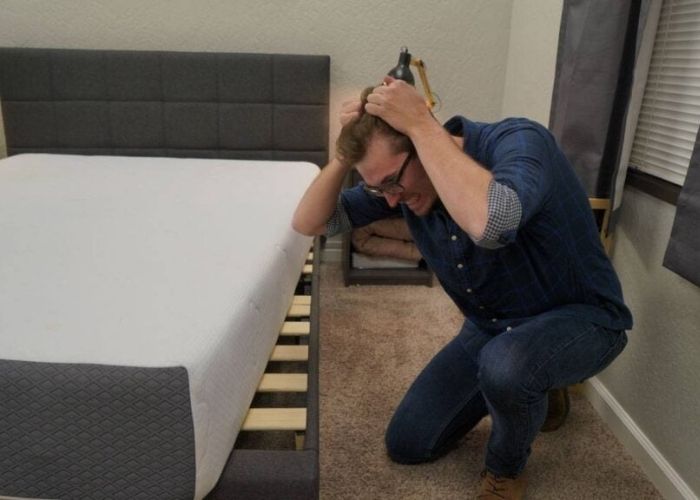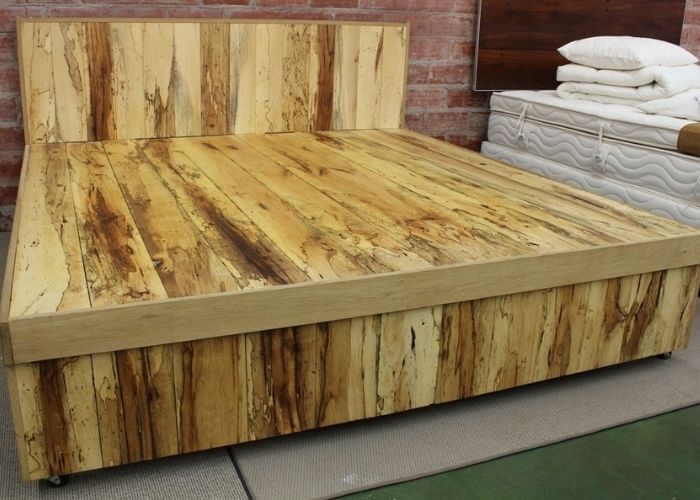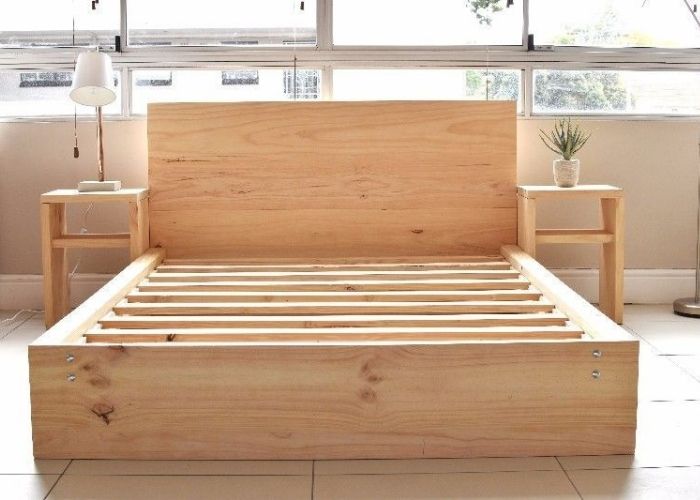Wood is the material of choice for most people shopping for bed frames. Aside from being extremely sturdy, wooden bed frames are easier to assemble and are highly customizable.
However, many people rarely consider the type of wood when buying a bed frame. This is a big mistake as the type of wood determines the quality of the frame and even user comfort when sleeping.
Above all, the wood type directly determines the life expectancy of the bedframe. To this end, I have compiled a list of some of the best wood for bed frames.
Let’s begin with a straight answer, though;
What’s the Best Wood for Bed Frame?
Common hardwoods, such as maple, cherry, mahogany, and teak wood, are considered the best wood for constructing bed frames. Although softwoods, such as pine and cedar, are easier to shape, they aren’t as strong as their hardwood counterparts and, thus, might not last very long.
Poplar wood deserves consideration for those seeking an economical solution with ample creative freedom. Its budget-friendly nature makes it ideal for first-time bed builders or cost-conscious projects.
Additionally, its fine grain readily accepts stains and paints, offering a versatile platform for diverse aesthetic preferences. Poplar easily accommodates your vision, whether you envision bold geometric patterns for a contemporary flair or a warm stain for a rustic charm.
Pros and Cons of Wooden Bed Frames
Now, let’s consider why you should consider wood over materials for bed frame construction in the first place. Why wood and not metal, for example?
Pros of Wooden Bed Frames
- Sustainable: The most significant advantage of wood over other bed frame materials is sustainability. Unlike metal which doesn’t decay, wood products easily decompose and become manure that benefits the growth of new trees.
- Style options: Wood is a lot easier to style than metal. This can be a big deal if you want to add intricate details to your bed frame. Drilling through wood pieces to add ornamentation to your bed frame is much easier. Also, if you’re craving a bedroom that exudes warmth and character? A timber bed frame creates a timeless focal point, instantly elevating your space from ordinary to extraordinary.
- Durability: Wood is very durable. Yes, metal frames last a lifetime. But so do most hardwood products. For instance, walnut wood products easily last 70+ years; some can last a century with good maintenance.
- Practicality: Although metal is a great option, rusting and exposure to electromagnetic fields (EMF) make it less practical for bed frames. Studies show metal beds expose you to insomnia, headaches, and nightmares.
Cons of Wooden Bed Frames
- Cost: Unfortunately, the best wooden bedframes are significantly more expensive than metal frames. For instance, in-demand hardwoods, such as oak, cost tens of dollars per foot, making the bed frames very expensive.
- Weight: Weight generally depends on the type of wood. However, the best wood for bed frames is typically heavier than metal frames. This may present a problem when moving the bed or moving houses.
Best Wood to Make a Bed Frame: Softwoods vs. Hardwoods

So, we now know that wood is the best material for bed frames. But how do soft and hardwoods compare in bedframe making? Are both types of wood bed frames okay?
The short answer is – yes. Both hardwoods and softwoods are good for making a bed frame. Some softwoods are even better than some softwoods for bedframes.
The most important thing to remember is that hardwoods (from flowering trees (dicots)) are generally harder than softwoods, thus more durable and wear-resistant.
They tend to last longer and require less maintenance too. Above all, hardwoods tend to have more distinctive grain structures and a darker color than most people like.
However, hardwood products, including bed frames, are significantly more expensive than their softwood counterparts. Meanwhile, obtained from coniferous trees, softwoods stand out for their workability and availability.
These two qualities mean softwood products are far more affordable than hardwood ones. Softwoods also tend to be lighter (weight).
So, you should go for a hardwood frame if you focus on getting quality; durability, style, and budget aren’t an issue. However, a soft wood bedframe would be a great choice if you’re looking for a short-term solution on a budget.
Read also: best wood for raised beds.
Best Wood for Bed Frame (Updated List)
Let’s now look at seven of the best types of wood for bed frames. The list heavily features hardwoods, as you’d guess. However, we’ve also included a few excellent softwood options to consider.
1. Douglas Fir
The Douglas Fir is originally native to North America, mainly growing along the Pacific coast of British Columbia to California. It’s a medium-weight hardwood, though fairly hard but elastic.
It’s also subject to low shrinkage and has good stability. Sapwood and heartwood are quite different in color. While the sapwood is yellowish to reddish-white, the heartwood is yellowish-brown to reddish-yellow.
This gives Douglas Fir furniture a striking appearance. It is also naturally resistant to fungal and insect attacks and exhibits exceptional weather resistance when exposed to extreme conditions.
The reddish-brown hue and pronounced growth rings of Douglas Fir lend a natural beauty to any bedroom. Its distinctive grain patterns create a welcoming rustic ambiance, suitable for both traditional and contemporary settings.
Another interesting fact about Douglas Fir is that it emits a subtle, woody scent that some find calming and conducive to sleep. This sensory experience can enhance your bedtime routine and promote relaxation.
What I Liked Most
- Comes in longer-than-average board lengths
- A strong wood for the bed frame. It can last for generations
- It’s water and moisture-resistant
- Easy to maintain and refinish
What Could Be Improved
- Easily dents and scratches compared to other hardwoods
- Fairly expensive
2. Oakwood
Oak is another wonderful choice when shopping for a wooden bed frame. It’s a hardwood that tends to be very grainy. It’s also hard enough to withstand everyday use. Above all, oak is highly resistant to warping.
You’ll need to choose between white and red oak, though. White oak has a tiger stripe grain pattern with yellow rays and flecks.
Meanwhile, red oak ranges from light brown to pinkish red, with a swirling, water-like grain pattern – making it the more beautiful of the two.
What I Liked Most
- Extremely durable (can last a lifetime)
- Highly resistant to warping
- Has a distinctive and striking grain pattern
- Highly resistant to insect and fungal attacks
What Could Be Improved
- Staining darkens the hue
- It is a bit expensive
3. Walnut
You’ve probably heard about walnut wood. Many woodworkers consider it a top pick for making headboards. However, it’s also an excellent choice for bedframes.
It’s straight-grained hardwood in a chocolate-brown hue (the heartwood) or yellow (the sapwood). Whichever the case, a clear coating or oiling brings out the color.
Walnut is also extremely durable. And very dimensionally stable. It rarely changes shape, even in extreme conditions.
Unlike trendy woods that can quickly feel dated, Walnut’s rich, chocolate-brown tone effortlessly adapts to both modern minimalism and classic elegance. Imagine it anchoring a sleek, platform bed alongside crisp white linens in a contemporary space or harmonizing with warm wood tones and patterned bedding in a traditional bedroom.
While its color plays a key role, Walnut’s versatility extends beyond its visual appeal. Its natural grain patterns add subtle texture and interest, ensuring it never feels flat or one-dimensional.
Additionally, walnut lumber is highly shock-resistant. As a result, it doesn’t break easily under sudden load.
What I Liked Most
- It’s a highly workable wood
- Has decent bending qualities
- Comes in several unique colors
- Durable, robust, and not heavy
What Could Be Improved
- It’s one of the most expensive woods
- The color variations, from dark to light, can be off-putting
4. Maple
When I mention maple, I mean hard maple, also known as sugar maple or rock maple. Most woodworkers use maple sapwood rather than heartwood for making furniture, as the sapwood is easier to work with and more beautiful.
The sapwood color ranges from nearly white to an off-white cream, with a reddish or golden hue. Meanwhile, the heartwood is reddish-brown. It has a fine, straight-grain texture.
Unfortunately, maple is rated toxic as it can trigger allergic reactions. It’s also slightly heavier than other hardwood species. Additionally, it’s not as insect-resistant as you’d want for a bed frame.
So, you need to treat it properly before use.
What I Liked Most
- Moderately priced hardwood
- Easy to work and style
- Natural beauty with a striking, fine-grain pattern
- Hard and highly durable
What Could Be Improved
- Not very resistant to insects
5. Mahogany
Because of its reliability, strength, and aesthetic qualities, mahogany is a popular choice for many woodworking projects, including making bed frames and even the best natural wood epoxy table.
Timber from mahogany trees is characterized by beautiful straight and even grain patterns. Additionally, the lumber sands easily and takes stain very well.
Mahogany also stands out for its high resistance to water and moisture. It doesn’t shrink, warm, or swell even during harsh weather.
The reddish-brown color wood darkens over time, creating a red sheen when polished. Just remember that mahogany dust can trigger allergic reactions.
What I Liked Most
- Highly workable and excellent finishing properties
- Easily withstands extreme weather
- Beautiful reddish-brown wood
- It’s extremely durable
What Could Be Improved
- Lots of fakes (beware)
- It’s expensive
6. Pinewood
Pine is a softwood. It belongs to a family of trees known as conifers which are cone-bearing seed plants. However, this doesn’t mean that it’s too soft.
The lumber from pine is very strong and highly durable. Although it’s not ideal for outdoor furniture, it’s an excellent choice for indoor furniture, including bed frames.
Pine comes in about 126 varieties. However, the two most popular species are yellow pine and white pine. White pine is especially common. A light, whitish color with a medium texture and a closed-grain pattern characterize it.
What I Liked Most
- Pine is widely available
- Attractive grain pattern
- Highly durable but easily workable
- Pine wood is inexpensive
What Could Be Improved
- Scratches and dents easily
- Requires significant care/maintenance
7. Cedar
Cedar is also a good choice if you’d prefer softwood for your bed frame. If you’re wondering, it’s slightly softer than pine. While white pine is rated 420 Janka, Cedar is only around 320 Janka.
By comparison, hardwoods such as mahogany and maple are rated 1,000+ Janka. However, you don’t have to worry, as the Janka rating isn’t the most important factor when assessing wood quality.
For instance, cedarwood is considered one of the most durable woods. It lasts decades, even centuries, with good maintenance.
Additionally, cedar is highly workable and has a uniformly textured grain pattern, making it easy to fit into the modern home. It’s also the best wood for exterior shutters.
What I Liked Most
- Very durable wood, more than many hardwoods
- Excellent workability & accepts stains well
- Lightweight
- Red cedar is an excellent thermal insulator
What Could Be Improved
- It’s not very strong
- It tends to fade in color over the years
8. Cherry
Finally, many woodworkers love using cherry wood for bed frames and slats. It’s also applicable to other wood furniture, including outdoor furniture and garden wood Adirondack chairs.
For one, cherry wood is very durable. It’s not the most durable hardwood. However, heartwood is highly decay-resistant. Natural cherry wood bed frames are light pink-toned.
However, the wood naturally darks from oxidation into a medium red-toned or reddish-brown color. It has a straight grain and fine, uniform, smooth texture. Cherry is highly durable and strong.
What I Liked Most
- Durable, long-lasting wood
- Very attractive colors
- Very strong
- Wide range of applications
What Could Be Improved
- Quite expensive, even more than oak
- Not resistant to water damage
Is your bed constantly on the move, sliding around on your beautiful wood floors? It can be a frustrating and noisy problem, but fear not! We’ve got you covered with a comprehensive guide on how to stop bed from sliding on wood floor.
Other Top Factors to Consider When Choosing the Best Wood to Build a Bed Frame
As you’d imagine, wood type isn’t the only thing you should consider when making a wood bed frame. The following are four other important considerations;
1. Weight
Generally, heavier frames can support more weight. However, heavier frames are also less mobile, thus difficult to move when repositioning the bed or moving homes.
2. Ease of assembly
Ease of assembly is especially a major consideration for people with mobility issues. Choosing a bed frame that you can easily assemble is preferable, even without help.
3. Noise

Wood has a property to swell and contract with weather changes. This came cause creaking noises while you sleep. So, it’s important to consider the dimensional stability of the wood and frame.
4. Size
Finally, always make sure you’re getting the right size bed. Remember that you spend about a third of your life asleep. You don’t want to spend all that time in an uncomfortable bed.
Recommended Reading: What is the best wood for wood burning art?
Lumber for Bed Frame FAQs
How much do wood bed frames cost?
A wood bed frame costs anywhere between $300 to $700. However, high-end models cost $1,000+. It depends on many factors, including the particular type of wood.
What type of wood is best for bed frames?

Rich woods like oak, walnut, and maple are the best choices for making bed frames, but pine and cedar, popular in the furniture industry, are excellent alternatives; they also make the best wooden columns for front porch. These wood types can also serve as great bow wood due to their strength and flexibility.
How can I stop a wooden bed frame from squeaking?
First, choose the right type of wood to stop your bed frame from squeaking. Dimensionally stable wood rarely makes noise. In addition, consider tightening the joints, cushioning the slats, and oiling the frame.
Is cedar a good wood for a sauna?
Yes, apart from being an excellent wood for a bed frame, cedar is also the best sauna wood. Cedar wood is highly favored for sauna construction due to its durability, heat insulation, aromatic qualities, and low maintenance. It resists decay, retains heat, and adds a pleasant aroma.
Is pine wood strong enough for a bed?
Pine is an excellent choice for crafting beautiful wooden bed frames. Despite being a softwood, it offers remarkable durability. Moreover, pine stands out as the best wood to make shelves and bed frames due to its availability and affordability. White and yellow pine are highly recommended options for these versatile projects.
How can I make my bed stronger?
There are several ways to make your bed slats and frame stronger. For instance, consider putting box springs or some plywood over the bed slats. You can also secure the slats, add more, and reinforce the supporting center beam.
Is cherry wood suitable for making tool handles?
Cherry wood can be used for making tool handles, including a wooden axe handle. It offers good durability and strength, making it a viable option for various tools and even desktop lumber. However, the suitability of desktop lumber depends on the specific requirements and preferences of the user.
Next, read about the best wood for exterior columns.
What Wood to Use for Bed Frame Summary
All the types of wood discussed above are excellent wood choices for making a bed frame. They are also durable wood types with low maintenance (relative to other options) and high resistance to insect attacks and weather conditions.
So, it comes down to what bed frame you want, your budget, and other factors, such as aesthetic preferences.

